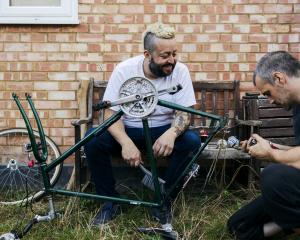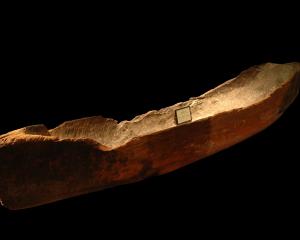
First-hand tales of alien abductions and daytime heat that seems to come from another solar system’s bigger star - artist Jess Johnson is in her element.
Both are courtesy of Roswell, where she is doing a year-long residency in the remote high desert.
Lately, that has involved days north of 40°C and just last month the New Mexico town held its annual UFO Festival, which included an "amazing symposium of speakers and panels", she says.
"People telling their first-hand accounts of alien abductions.
"It is a dream being here."
A dream, but no accident - Johnson has had her eye on the residency for some time, waiting for the right time to beam in.
While there, the New Zealand artist hopes to have time and space to let her imagination journey off in some new directions - or, perhaps more likely, some new dimensions.
Like the science fiction from which Johnson draws some of her inspiration, her art is not subject to the normal laws of physics.
Proof of that is on display from today at Tūhura Otago Museum, where the interactive VR headset-platformed exhibition "Terminus" is opening, and where her new planetarium film XYZZY is having its international premiere.
"Terminus" drops viewers into five immersive worlds of Johnson’s creation; psychedelic spaces that collapse the space between the ancient and the distant future, reflecting "ideologies of technology and flesh".
The VR experiences are created in partnership with film-maker Simon Ward, who builds the minutely detailed 3-D worlds from hand drawings by Johnson.
The new planetarium film draws from the same well, Ward manipulating images from a vast database of Johnson’s art, setting the whole to specially commissioned electronic music by Andrew Clarke, Luke Rowell and Stef Animal.
Johnson, who is in town for the twin unveilings, says Roswell and her fictional worlds are connected in other ways too.
Designs created for the "Terminus" exhibition carry a hint of Johnson’s own familial connection to Mexico.
"My mother is Mexican American, my middle name is Juanita - named after my grandmother."
The Mt Maunganui-raised artist says she cannot claim a deep connection to Mexican culture, but that part of her family history is not unexplored.
"There is definite influence from old - what would you say? - lineages of craft and things like that. My mother was a quilt maker, so she was always in the corner of the lounge room cutting up material and piecing together and making these really elaborate patterned patchwork quilts - and I think there is a similar construction in my drawings and the geometries and patterns that I use, from mum’s analogue quilt making to my analogue drawing."
In the likes of "Terminus", those beginnings become digitised and deified, multiplied and amplified.
Christchurch art school-trained Johnson has been drawing fulltime, building these worlds for more than a decade now in what she describes as a long, slow dredging process.
"The ideas and the nature of the world definitely wasn’t fully formed when I started basing all my drawings within the same realm in 2012. It has been a very organic building of the cosmology, or the narrative and the characters, over the past decade."

They were both aware of each other’s work and immediately set about animating her imagery. They have not stopped.
"Quite early on, we got this commission to make a VR artwork on one of the early developer models and that led to this larger commission with the National Gallery of Australia. Everything has kind of led into bigger and bigger projects."
Ward has a different skill set to her, she says.
"He is able to do these incredible things with the analogue drawings that I make.
"My tool kit is pen and paper. His is this digital world."
Among other things, Johnson likes that their work together has made the art accessible to more people. Not only does it fill gallery spaces but can also be downloaded from online VR stores.
"That is kind of interesting for us because it reaches the online gaming community, who wouldn’t necessarily be able to catch one of our exhibitions in a gallery, or have the inclination to go to a gallery."
The planetarium project, XYZZY, has the potential to extend that reach further still.
"A lot of planetariums, they are all over the world, and they are often in these weird out-of-the-way places, off the beaten track - like the Roswell Museum has a planetarium attached to it. It means that the work can travel after it has been premiered at Otago. It means it can travel to planetariums all over the world, and hopefully reach these audiences that might not have so much access to contemporary art."
But it is by no means all about the digital and the projectable for Johnson - the gallery space at Tūhura that will host "Terminus" will be wallpapered with tangible examples of her work, creating a physical world within which the VR experiences can play out.
"I think I am definitely a maximalist by nature," Johnson says of this layered approach. "That is evident in my drawings and the detail and the orders of obsession I get into with the drawings themselves; but then in terms of the audience experience, going in to see one of our exhibitions in a gallery, I like to offer a level of generosity of what people are going to see in the gallery."
It is all designed to have an impact. And it does.
People cry, then email Johnson later to say how profoundly affected they were.
For some, the VR worlds are quite dystopian; human forms locked in inescapable cycles of action and formidable creatures summoned from the id.
Johnson gets that, though it has never been her intention or her experience.
"But I never wanted to be didactic or tell people what their experience should be. I think there is enough space amongst it all for people to project their own stuff into the cracks."
Transporting their work to the planetarium is a whole new ball game, though their VR experience helped in terms of considering space beyond a flat screen, she says.
"There were all these other new considerations to make. The fact that you can’t show the floor in a planetarium."
They had to think about where the horizons were and how to transport people from one place to another - all without inducing nausea.
"You have a tendency, you want to throw all these psychedelic patterns or weird falling movements."
During the making, Ward would take demos into the Wellington or Otago Museum planetarium to test them.
As a piece of film, it is very driven by the pieces of music, the commissions for which stipulated a tone or a mood, Johnson says.
"Then those were pieced together in tonal journey, or an emotional journey and then the musical tracks influenced a lot of the imagery, the visuals that Simon was choosing to accompany it.
"There is a narrative but ... like a lot of our work, there is always a journey or a quest and it is always very cyclical. We always return to the beginning. That was kind of the themes that "Terminus" was based around as well. So there is a narrative in it but it is more an emotional narrative, it is not language based."
The shows
The Jess Johnson and Simon Ward exhibition "Terminus" runs until February 25. Bookings for the VR experiences are essential.
* Contains mature themes.
XYZZY, the new planetarium show by Jess Johnson and Simon Ward.
Screenings daily at 3.30pm.
Adults $15, concession $12, children $9.












